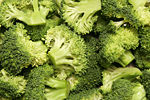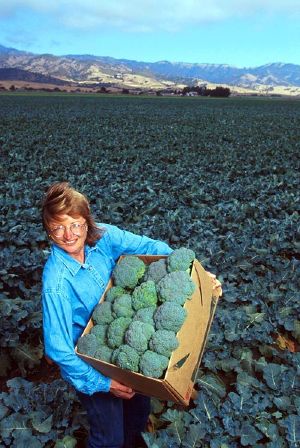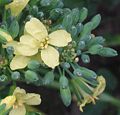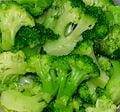Difference between revisions of "Broccoli" - New World Encyclopedia
Svemir Brkic (talk | contribs) m (Fix category tag) |
Rick Swarts (talk | contribs) |
||
| Line 10: | Line 10: | ||
}} | }} | ||
| − | '''Broccoli''' is a green | + | '''Broccoli''' is a green [[vegetable]] (''Brassica oleracea'' var. ''italica'') in the [[flowering plant]] family [[Brassicaceae]] (formerly Cruciferae), characterized by fleshy green flower heads arranged in a tree-like fashion on branches sprouting from a thick, edible stalk. The term broccoli also is used for the edible flower clusters and stalk of this plant. |
| + | |||
| + | Broccoli closely resembles the vegetable [[cauliflower]], which is the same species as broccoli, ''Brassica oleracea'', but a different cultivar, though broccoli is green rather than white like cauliflower. | ||
| + | |||
| + | Broccoli is a good source of vitamin C, iron, fiber, potassium, vitamin A, calcium, zinc, magnesium, carotene, and vitamin B. It is thought to be important in the prevention of certain types of cancer, along with diabetes, heart disease, osteoporosis, and high blood pressure (Allen and Allen 2007). | ||
| + | |||
| + | ==Description== | ||
| + | The plant family ''Brassicaceae'' (also called ''Cruciferae''), to which broccoli belongs, is known as the "mustard family" or "cabbage family." The family contains species of great economic importance, providing much of the world's winter vegetables. These include [[cabbage]], broccoli, [[cauliflower]], [[brussels sprout]]s, [[collard]]s, and [[kale]] (all cultivars of one species, ''[[Brassica oleracea]]''), [[Chinese kale]], [[rutabaga]] (also known as Swedish turnips or swedes), [[seakale]], [[Brassica rapa|turnip]], [[radish]] and [[Kohl Rabi|kohl rabi]]. Other well known members of the Brassicaceae include [[rapeseed]] ([[canola]] and others), [[mustard plant|mustard]], [[horseradish]], [[wasabi]] and [[watercress]]. | ||
| + | |||
| + | The family was formerly named Cruciferae ("cross-bearing"), because the four [[petal]]s of their [[flower]]s are reminiscent of crosses. Many botanists still refer to members of the family as "crucifers." According to [[ICBN]] Art. 18.5 (St Louis Code) Cruciferae is to be regarded as validly published, and is thus an accepted alternate name. The name Brassicaceae is derived from the included genus ''Brassica''. | ||
| + | |||
| + | Broccoli is classified as the Italica [[cultivar]] of the species ''[[Brassica oleracea]]''. (A ''cultivar'' is a cultivated plant defined by a specific, heritable set of characteristics.) It has a dense cluster of [[flower]] buds, which are green. The large mass of flower heads is surrounded by leaves. | ||
| + | |||
| + | Common varieties of broccoli include calabrese and purple sprouting broccoli. | ||
==Cultivation, preparation and nutritional value== | ==Cultivation, preparation and nutritional value== | ||
| Line 49: | Line 62: | ||
</gallery> | </gallery> | ||
| − | ==References | + | ==References== |
| − | < | + | <ref> Allen, R., Allen, Z. 2007. [http://www.vegparadise.com/highestperch44.html#Nutrition Broccoli: The Crown Jewel of Nutrition]. ''Vegetarians in Paradise''. Retrieved July 29, 2007. </ref> |
| + | |||
| + | |||
| + | * Herbst, S. T. 2001. ''The New Food Lover's Companion: Comprehensive Definitions of Nearly 6,000 Food, Drink, and Culinary Terms. Barron's Cooking Guide''. Hauppauge, NY: Barron's Educational Series. ISBN 0764112589 | ||
==External links== | ==External links== | ||
| Line 58: | Line 74: | ||
* [http://www.photo.net/photodb/photo?photo_id=1236856 Photograph of the distinctive Broccoli romanesco.] | * [http://www.photo.net/photodb/photo?photo_id=1236856 Photograph of the distinctive Broccoli romanesco.] | ||
| − | {{credit|Broccoli|144367277}} | + | {{credit|Broccoli|144367277|Brassicaceae|149213211}} |
[[Category:Life sciences]] | [[Category:Life sciences]] | ||
Revision as of 23:58, 15 August 2007
| Broccoli |
|---|

|
| Species |
| Brassica oleracea
|
| Origin |
| possibly Ancient Rome |
| Cultivar Group members |
| Many; see text. |
Broccoli is a green vegetable (Brassica oleracea var. italica) in the flowering plant family Brassicaceae (formerly Cruciferae), characterized by fleshy green flower heads arranged in a tree-like fashion on branches sprouting from a thick, edible stalk. The term broccoli also is used for the edible flower clusters and stalk of this plant.
Broccoli closely resembles the vegetable cauliflower, which is the same species as broccoli, Brassica oleracea, but a different cultivar, though broccoli is green rather than white like cauliflower.
Broccoli is a good source of vitamin C, iron, fiber, potassium, vitamin A, calcium, zinc, magnesium, carotene, and vitamin B. It is thought to be important in the prevention of certain types of cancer, along with diabetes, heart disease, osteoporosis, and high blood pressure (Allen and Allen 2007).
Description
The plant family Brassicaceae (also called Cruciferae), to which broccoli belongs, is known as the "mustard family" or "cabbage family." The family contains species of great economic importance, providing much of the world's winter vegetables. These include cabbage, broccoli, cauliflower, brussels sprouts, collards, and kale (all cultivars of one species, Brassica oleracea), Chinese kale, rutabaga (also known as Swedish turnips or swedes), seakale, turnip, radish and kohl rabi. Other well known members of the Brassicaceae include rapeseed (canola and others), mustard, horseradish, wasabi and watercress.
The family was formerly named Cruciferae ("cross-bearing"), because the four petals of their flowers are reminiscent of crosses. Many botanists still refer to members of the family as "crucifers." According to ICBN Art. 18.5 (St Louis Code) Cruciferae is to be regarded as validly published, and is thus an accepted alternate name. The name Brassicaceae is derived from the included genus Brassica.
Broccoli is classified as the Italica cultivar of the species Brassica oleracea. (A cultivar is a cultivated plant defined by a specific, heritable set of characteristics.) It has a dense cluster of flower buds, which are green. The large mass of flower heads is surrounded by leaves.
Common varieties of broccoli include calabrese and purple sprouting broccoli.
Cultivation, preparation and nutritional value
Broccoli is a cool-weather crop that does poorly in hot summer weather. It is usually boiled or steamed, but may be eaten raw and has become popular as a raw vegetable in hors-d'oeuvre trays. It is high in vitamin C, vitamin A and soluble fiber and contains the multiple nutrients with potent anti-cancer properties including diindolylmethane and selenium. The 3,3'-Diindolylmethane found in broccoli is a potent modulator of the innate immune response system with anti-viral, anti-bacterial and anti-cancer activity.[1] Broccoli also contains the compound glucoraphanin, which can be processed into an anticancer compound sulforaphane. The nutritional benefits of broccoli, however, are reduced if the vegetable is boiled.[2]
History of broccoli
Broccoli is a cultivar of wild cabbage. Wild cabbage originated along the northern and western coasts of the Mediterranean, where it was apparently domesticated thousands of years ago. That domesticated cabbage was eventually bred into wildly different cultivars, including broccoli, cauliflower, cabbage, kale, kohlrabi, and brussels sprouts, all of which remain the within the same species.
Roman references to a cabbage-family vegetable that may have been broccoli are not entirely clear. The Roman natural history writer, Pliny the Elder, wrote about a vegetable that fits the description of broccoli and some vegetable scholars recognize broccoli in the cookbook of Apicius.
Broccoli was an Italian vegetable, as its name suggests, long before it was eaten elsewhere. It is first mentioned in France in 1560, but in 1724 broccoli was still so unfamiliar in England that Philip Miller's Gardener's Dictionary (1724 edition) referred to it as a stranger in England and explained it as "sprout colli-flower" or "Italian asparagus." In the American colonies, Thomas Jefferson was also an experimental gardener with a wide circle of European correspondents, from whom he got packets of seeds for rare vegetables such as tomatoes. He noted the planting of broccoli at Monticello along with radishes, lettuce, and cauliflower on May 27, 1767. Nevertheless, broccoli remained an exotic plant in American gardens. In 1775, John Randolph, in A Treatise on Gardening by a Citizen of Virginia, felt he had to explain about broccoli: "The stems will eat like Asparagus, and the heads like Cauliflower."
Commercial cultivation of broccoli in the United States can be traced to the D'Arrigo brothers, Stephano and Andrea, immigrants from Messina, Italy, whose company made some tentative plantings in San Jose, California in 1922. A few crates were initially shipped to Boston, where there was a thriving Italian immigrant culture in the North End. The broccoli business boomed, with the D'Arrigo's brand name "Andy Boy" named after Stephano's two-year-old son, Andrew, supported by advertisements on the radio.
Broccoli and cauliflower, which are actually cultivars of the same species, have been crossbred to produce brocciflower. It was first cultivated in Europe around 1988. Its very pale green heads are densely packed like cauliflower but it has the flavor of broccoli.
The word broccoli comes from the Latin brachium, meaning arm, via the Italian braccio.
Varieties
The two main types of broccoli are heading and sprouting. There are three commonly grown varieties of broccoli. The calabrese is the most familiar, with large green heads and thick stalks, and is named after Calabria, the region in Italy where it was first cultivated. It is planted in spring and farmed in August.
Sprouting broccoli has a larger number of heads with many thin stalks. It is planted in May to be harvested during the winter or early the following year.
Romanesco broccoli has numerous small cone-shaped heads arranged in spirals, and is yellow-green in color.
White and purple varieties are also available in some areas. Other cultivar groups of the species Brassica oleracea include: cabbage (Capitata Group), cauliflower (Botrytis Group), kale and collard greens (Acephala Group), kohlrabi (Gongylodes Group), and Brussels sprouts (Gemmifera Group). Chinese broccoli (Alboglabra Group) is also a cultivar group of Brassica oleracea.
Gallery
Romanesco broccoli, showing fractal forms
ReferencesISBN links support NWE through referral fees
- Herbst, S. T. 2001. The New Food Lover's Companion: Comprehensive Definitions of Nearly 6,000 Food, Drink, and Culinary Terms. Barron's Cooking Guide. Hauppauge, NY: Barron's Educational Series. ISBN 0764112589
External links
- PROTAbase on Brassica oleracea (cauliflower and broccoli)
- Photograph of the distinctive Broccoli romanesco.
Credits
New World Encyclopedia writers and editors rewrote and completed the Wikipedia article in accordance with New World Encyclopedia standards. This article abides by terms of the Creative Commons CC-by-sa 3.0 License (CC-by-sa), which may be used and disseminated with proper attribution. Credit is due under the terms of this license that can reference both the New World Encyclopedia contributors and the selfless volunteer contributors of the Wikimedia Foundation. To cite this article click here for a list of acceptable citing formats.The history of earlier contributions by wikipedians is accessible to researchers here:
The history of this article since it was imported to New World Encyclopedia:
Note: Some restrictions may apply to use of individual images which are separately licensed.
- ↑ University of California, Berkeley. 2007. [ http://www.diindolylmethane.org Diindolylmethane Information Resource Center at the University of California, Berkeley] Retrieved June 10, 2007.
- ↑ University of Warwick Media Centre. 2007. Research Says Boiling Broccoli Ruins Its Anti Cancer Properties. University of Warwick Medical School News. Retrieved June 10, 2007.
- ↑ Allen, R., Allen, Z. 2007. Broccoli: The Crown Jewel of Nutrition. Vegetarians in Paradise. Retrieved July 29, 2007.





